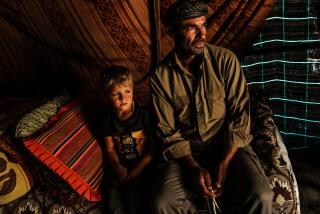The Swat Valley’s downhill slide
- Share via
WRITING FROM MINGORA, PAKISTAN — The drawing shows three boys in traditional Pakistani long shirts, shalwar kameez, crying and holding banners that read “We want peace,” “Not the peaces [sic] of human bodies” and, in Arabic script, “Aman” -- Pashto for “peace.” On the left of the group, two hooded men (members of the Taliban, one presumes) carry swords; on the right, two figures in uniform carry guns (Pakistani army, one guesses). In the foreground, a hooded figure holds down a person who is pleading, “Please let me go; I have small children.”
This was a drawing by a schoolgirl named Sheema for an end-of-Ramadan competition in Mingora, the main town of Pakistan’s Swat Valley in the North-West Frontier Province. The scene depicting her hometown this spring -- civilians caught between the militants and the army -- illustrates the huge human cost of the operation by the Pakistan army against the Taliban. And the suffering is far from over. After a week of talking to people living in the Swat Valley, displaced from Swat or working in Swat, I can attest that Sheema got it exactly right.
The tragedy of more than 2 million people being displaced in less than two months may have vanished from the headlines, but the civilian drama continues. If there is less attention to their needs, it’s partly because it’s still hard for anyone other than the armed forces or a native Swati to reach most of the district north of Mingora. The army can take foreign journalists on periodic tours of the “cleared” areas in the south but rarely in the north, where the situation remains uncertain. One thing is obvious: Beyond Mingora, the Swat Valley is still an insecure place.
The Pakistanis themselves have concerns for the collateral damage that the offensive has caused: A visit by the Human Rights Commission of Pakistan resulted in a strongly worded report about mass graves and extrajudicial “revenge” killings. And last week, the Pakistani daily and others reported that a 10-minute video apparently showing Pakistani soldiers beating men detained in anti-militant operations had surfaced on the Internet. The army is investigating.
If the restrictions caused by emergency army administration -- such as curfews and checkpoints -- are a nuisance and add risks for civilians, anger against the militants is rising too. The displaced return to areas promised to be “cleared” of militants, only to find it may not be so. People fear that if they are seen during daytime (from the hills where the militants tend to hide) having contact with any army or government personnel, the Taliban will come down at night to exact a heavy price on them.
Close to Peshawar, in Mardan, I met with some of the displaced people who have found temporary shelter there -- they number more than 1,000. Fourteen of the families are redisplaced -- i.e. they tried to return home and found it impossible to live there. What 35-year-old Selma mentions is typical: Before the army’s action, her daughters could not go to school because of Taliban-imposed rules, and one brother’s shop was judged un-Islamic -- for selling clothes catering to women -- and destroyed. Now the daughters cannot go to school because of the army-imposed curfew, and the army told her brothers to dismantle the homes of suspected militants (which exposes them to revenge). So after one month spent back in Charbagh, a former Taliban stronghold, the family opted to flee yet again.
The situation in other parts of the North-West Frontier Province remains unstable. Reporting about a militant attack in a market last month in Kohat, a local Pakistani newspaper wrote that for several hours after the blast, “an enraged crowd did not allow the bomb-disposal squad to enter the market.” How huge must be the people’s grief, and animosity toward those responsible for the mayhem, for them to shoo away Samaritans coming to rescue their loved ones.
The message in Sheema’s drawing gets confirmed with every conversation I have with those who fled the Swat Valley. It resonates across the troubled province, where another major anti-Taliban assault by the army is brewing, this time on the militant stronghold of South Waziristan. Hundreds of thousands more civilians may be forced to flee, caught between the army and the Taliban.
However, in Mingora and the territory just south of it, ringed by army checkpoints and crawling with street patrols, many wish for a civilian administration -- a sign that things could be genuinely stabilizing. The army is beginning to draw back in Mingora and hand over security to the police. There too I find a beaming principal of a private girls school, Ziauddin Yousafzai, whose enthusiasm over the “clearance” of Mingora is contagious. And his pupil, Sheema, has another, more hopeful drawing showing her high school reopened and boys and girls holding hands and smiling.
Were it that the rest of the Swat Valley could hold hands and smile.
More to Read
Sign up for Essential California
The most important California stories and recommendations in your inbox every morning.
You may occasionally receive promotional content from the Los Angeles Times.










